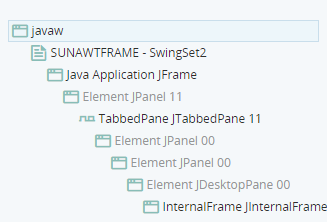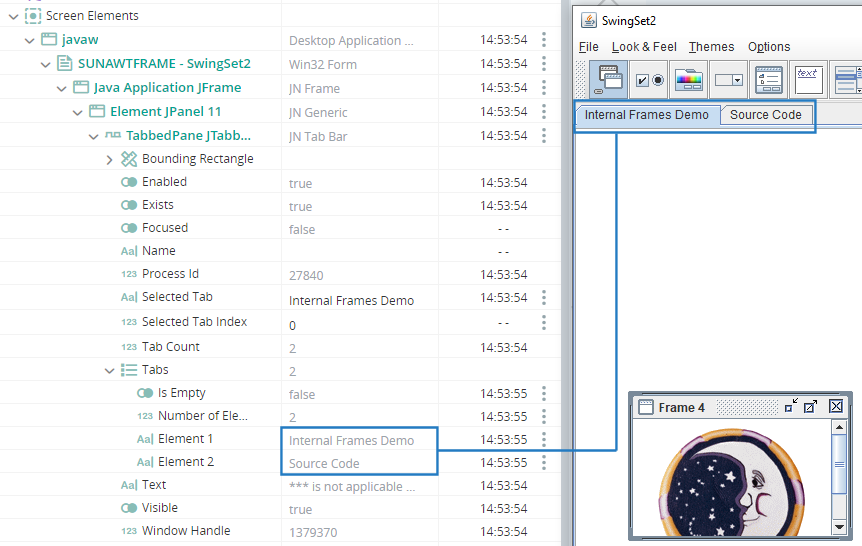Java Native Connector
(Available from version 7.3 onwards.)
Automation Studio is designed to provide powerful and reliable screen element capturing from applications that are based on Java, including Oracle forms.
This is Automation Studio's default Java Connector. If you enable the former Java Connector, this Java Connector is disabled.
Projects created with the former Java Connector are not supported by the Java Native Connector. If you need to work with such projects, enable the former Java Connector from the configuration.
Connector Features
The built-in Java connector provides the following features:
-
Capture any object in Java applications
-
Support for 32-bit and 64-bit architecture
-
From version 7.6, support for IBM Java Machine (1.1 and up)
Configure the Connector
No configuration is required for the Java Connector. This connector is enabled by default.
Capture a Screen Element
The procedure for capturing a screen element from a Java application is the same as for all screen elements. See Capture a Screen Element.
Edit a Screen Element
The Edit Screen Element window opens after capturing a screen element. This screen allows you to customize how the screen element is treated and identified. See Edit a Screen Element.
Information specific to Java application screen elements is provided below.
Element Hierarchy
The Java Native object hierarchy is automatically created as you capture Java Native screen elements. The tree conforms to the object filtering received from the Java Mapper, with the following additional physical objects added at the top of the hierarchy:
- The root screen element is a Process screen element, for example javaw in the tree below.
- The next level is the Win32 Form screen element, which is the parent to the rest of the screen elements, for example SUNAWFRAME in the tree below.
- The third level is the main Java frame, which is a JN Frame screen element, for example Java Application in the tree below.
See View the Element Hierarchy.
Screen Element Types Supported
The screen element type values available differ between levels in the hierarchy.
|
Type |
Screen Element Types |
|---|---|
|
Java General Screen Element |
|
|
Form |
|
|
Java Process |
|
Recognition Properties Supported
|
Property |
Description |
|---|---|
| My Window Class Name is | The name of the class to which the screen element belongs. |
| My Window Children Count is | The number of child objects. |
| My Window Visibility is | Identifies a window based on its visibility. |
| My Window Relative Location is | Identifies a window based on the location of its parent window. |
| My Window Width is | Window width in pixels. |
| My Window Height is | Window height in pixels. |
| My Window Child Id is | The window ID. |
| My Window Z Order is | The window position in a stack of overlapping windows. |
| My Window Class Z Order is | The class of the window’s position in a stack of overlapping windows. |
| My Window Name is | A window name where Win32 physical object is hosted. |
| My Window Accessible Name is | Provides accessibility support. |
| My Child Window Class Name is | Gets the name of the class, to which the child object belongs. |
| My Child Window Name is | Indicates having a child with specified name. |
| My Child Window Accessible Name is | Indicates having a child with specified accessible name. |
| My Child Window Child Id is | Indicates having a child with this ID. |
| My Child Window Children Count is | Indicates having a child with defined children count. |
|
Property |
Description |
|---|---|
| My Process Name is | The name of the process, for example javaw. |
| My Process ID is | The ID issued by the operating system to uniquely identify an active process. For example, a text box control. |
| My Parent Process Name is | The name of the parent process, if such a process exists. |
| My Parent Process Name is not | The name of the process, which can’t be a parent process |
| My Process Level is | The process level in the process tree. This enables you to handle scenarios where applications have more than one process on different levels. |
|
Property |
Description |
|---|---|
|
Index in Container |
The index number of the screen element in its container. When you are working with Oracle forms, the object hierarchy is dynamic, therefore the index number of an object in its container is not consistent. As a result, the Index in Container property cannot be used to accurately identify the frame. In this case, if this property is selected by default, deselect it, and used Visual Index property instead. |
|
Java Class Name |
The Java name of the screen element's class. |
|
Path |
The path to the screen element. |
|
Visual Index |
The visual index (topology) of the screen element. |
|
Text |
The text value of the screen element, if applicable. |
|
Width |
The width of the screen element. |
|
Height |
The height of the screen element. |
|
Top Offset in Window |
The top offset of the screen element in the main Java window. |
|
Left Offset in Window |
The left offset of the screen element in the main Java window. |
|
Top Offset in Container |
The top offset of the screen element in its container. |
|
Left Offset in Container |
The left offset of the screen element in its container. |
Main Relation Type
The element's main relation type is displayed in the Edit Screen Element window, but cannot be changed.
This section is not displayed for the Java process.
See Identify an Element's Main Relation Type.
Multi Instance Support
The Java connector provides support for multiple instances of a JAVA application.
You can specify which instance of the application to relate to if multiple instance of the same application are open.
Multi instance support differs between levels in the hierarchy.
|
Type |
Multi Instance Support |
|---|---|
| JAVA NATIVE GENERAL SCREEN ELEMENTS |
Optional, inactive by default Options: Last Focused, First Recognized, or Last Recognized. |
|
JAVA NATIVE MAIN WINDOW SCREEN ELEMENT |
Optional, inactive by default Options: Last Focused, First Recognized, or Last Recognized. |
|
JAVA NATIVE PROCESS SCREEN ELEMENT |
Active by default, cannot be deactivated. |
See Set Multi Instance Behavior
Screen Element Assets
Each screen elements has its own properties, functions, and events. These are visible in the Assets Panel.
For information on screen element assets, see here.
Monitor Screen Elements in Debug Mode
When in debug mode, you can view and modify the values of a screen element's properties.
For example, a tab's text can be viewed during debug.



